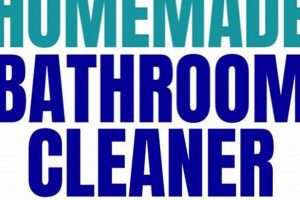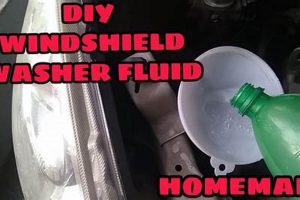The act of personally cleaning and detailing one’s own vehicle, foregoing professional services, defines a self-executed automotive cleaning process. This encompasses a range of activities, from simple washing and rinsing to more complex procedures like waxing, polishing, and interior detailing, all performed by the vehicle owner.
The motivation behind choosing to undertake this task is multifaceted. Cost savings represent a primary driver, as professional detailing services can incur significant expenses. Furthermore, it allows for meticulous control over the products used and the level of detail applied. Historically, maintaining a vehicle’s appearance was a common practice, evolving from basic cleaning to a more refined and specialized approach with the advent of advanced cleaning agents and tools.
Subsequent sections will delve into the specific techniques involved, necessary equipment, appropriate cleaning agents, and considerations for achieving optimal results while minimizing environmental impact. It also discuss tips and trick to making this process an efficient means of vehicle care.
DIY Car Wash Tips
Effective vehicle cleaning necessitates adherence to established best practices to ensure optimal results and prevent potential damage. These guidelines promote both efficiency and long-term preservation of the vehicle’s finish.
Tip 1: Pre-Rinse Thoroughly: Prior to applying any cleaning agents, a comprehensive rinse is crucial. This step dislodges loose dirt, grime, and debris that could potentially scratch the paint surface during subsequent washing.
Tip 2: Utilize a Two-Bucket System: Employing two separate buckets, one for soapy water and one for rinsing the wash mitt, minimizes the transfer of contaminants back onto the vehicles surface. This reduces the risk of swirl marks and scratches.
Tip 3: Choose pH-Neutral Soap: Selecting a cleaning solution with a neutral pH balance prevents damage to the vehicle’s paint and protective coatings. Avoid harsh chemicals that can strip wax or clear coat.
Tip 4: Wash from Top to Bottom: Gravity dictates that dirt and grime flow downwards. Beginning with the upper surfaces and progressing downwards prevents recontamination of previously cleaned areas.
Tip 5: Dry with Microfiber Towels: Microfiber towels are exceptionally absorbent and gentle on paint surfaces. Their soft fibers minimize the risk of scratching compared to traditional drying methods.
Tip 6: Clean Wheels and Tires Separately: Brake dust and road grime are particularly abrasive. Using dedicated brushes and cleaning solutions for wheels and tires prevents the transfer of these contaminants to the vehicle’s paint.
Tip 7: Apply Wax or Sealant Regularly: Routine application of wax or sealant provides a protective layer against environmental elements, such as UV radiation, acid rain, and road salts. This helps preserve the vehicle’s paint finish and shine.
Implementing these techniques contributes to a cleaner, better-protected vehicle, extending the lifespan of the paint and maintaining its aesthetic appeal.
The final section provides a summary of the key points and emphasizes the long-term value of proper vehicle maintenance.
1. Cost-Effectiveness
The financial advantage derived from performing vehicle cleaning independently constitutes a significant factor in the decision-making process. The economic benefits, however, extend beyond simple monetary savings and encompass a range of considerations directly influencing long-term vehicle maintenance expenses.
- Reduced Service Charges
Opting for a self-administered cleaning regimen eliminates recurring expenses associated with professional detailing services. These services can vary significantly in price, dependent on the level of detail and the size of the vehicle. Over time, these accumulated costs can exceed the investment in necessary cleaning equipment and supplies.
- Extended Vehicle Appearance
Regular maintenance, even if performed at a basic level, contributes to preserving the vehicle’s exterior appearance. Preventing the build-up of environmental contaminants minimizes potential damage to the paint and clear coat, thereby reducing the need for costly paint correction or restoration services in the future.
- Controlled Product Costs
Selecting specific cleaning agents and detailing products allows for budget management. Consumers can choose products based on their individual needs and price points, avoiding the standardized, and often more expensive, product application performed by professional services.
- Mitigation of Minor Repairs
The act of regularly cleaning a vehicle allows for closer inspection of its exterior. Identifying minor issues, such as small scratches or chipped paint, allows for prompt intervention, preventing further deterioration and potential escalation into more substantial and costly repairs.
Ultimately, a commitment to independent vehicle cleaning yields substantial cost savings. By mitigating expenses associated with professional services, preserving the vehicle’s exterior, managing product expenditures, and addressing minor repairs proactively, a self-executed cleaning regimen contributes to a more economical vehicle ownership experience.
2. Product Selection
The choice of cleaning agents and detailing products represents a critical factor in the success and longevity of a self-administered vehicle cleaning process. Appropriate selection prevents damage to the vehicle’s surfaces and enhances the overall quality of the cleaning outcome.
- pH-Neutral Soap Importance
Automotive soaps formulated with a neutral pH balance are essential for preventing damage to the vehicle’s paint, clear coat, and any existing wax or sealant layers. Highly alkaline or acidic soaps can strip away protective coatings, leading to oxidation and premature wear. Using pH-neutral formulations preserves the integrity of the vehicle’s finish.
- Microfiber Towel Specification
The selection of microfiber towels, specifically those with a high GSM (grams per square meter), directly impacts the risk of scratching or swirling the paint surface. High-quality microfiber towels possess a soft, plush texture that effectively traps and lifts dirt particles without abrading the finish. Lower-quality or improperly maintained towels can introduce scratches.
- Wheel and Tire Cleaner Compatibility
Cleaning solutions formulated for wheels and tires should be compatible with the specific materials present. Acid-based cleaners, for example, can damage certain types of wheel finishes, such as polished aluminum or chrome. Selecting cleaners specifically designed for the wheel material prevents corrosion
, discoloration, and other forms of degradation. - Wax and Sealant Composition
The composition of wax or sealant products determines their level of protection against environmental elements and their longevity. Carnauba waxes provide a deep gloss but offer limited durability, while synthetic sealants offer enhanced protection and longevity. The appropriate choice depends on the user’s desired level of protection and aesthetic preference.
The synergistic effect of utilizing compatible and high-quality products significantly contributes to the overall success of a self-executed vehicle cleaning. Prioritizing product selection based on compatibility, material considerations, and performance characteristics maximizes the preservation of the vehicle’s finish and ensures a professional-grade cleaning outcome. This careful deliberation directly reflects the efficacy of engaging in a DIY car wash approach.
3. Equipment Proficiency
The competence in operating various cleaning instruments is a critical determinant of the outcome in any self-performed vehicle cleaning task. The effectiveness of a do-it-yourself car wash is intrinsically linked to the operator’s ability to utilize equipment properly, safeguarding against potential damage and maximizing cleaning efficiency. Ineffective or improper use of equipment can result in outcomes ranging from superficial scratches to significant damage to the vehicle’s paint or other surfaces. For example, an inexperienced user wielding a pressure washer may hold the nozzle too close to the vehicle’s paint, causing the high-pressure stream to etch or strip the finish. Conversely, a user unfamiliar with the nuances of a dual-action polisher risks creating swirl marks or burning the paint, necessitating professional correction.
Real-world scenarios illustrate the practical significance of equipment proficiency. Consider the application of carnauba wax using an orbital buffer. A skilled operator understands the appropriate speed settings, pad selection, and overlapping techniques necessary to achieve an even distribution and optimal gloss. In contrast, an unskilled operator might apply excessive pressure, resulting in uneven wax application and potential damage to the clear coat. Similarly, the correct utilization of interior detailing equipment, such as steam cleaners and upholstery extractors, requires an understanding of temperature control and appropriate cleaning solutions to prevent discoloration or damage to the vehicle’s interior surfaces.
Therefore, achieving a successful self-executed vehicle cleaning necessitates a dedicated effort to acquire and refine the skills associated with each piece of equipment. This proficiency serves as a cornerstone of effective cleaning, mitigating risks and ensuring the preservation of the vehicle’s aesthetic and structural integrity. While selecting quality products is important, an individual’s practical understanding in leveraging their equipment for optimal use ultimately dictates the outcome.
4. Surface Protection
Surface protection represents a fundamental objective within the context of the DIY car wash process. The deliberate application of techniques and products aims to preserve the integrity and aesthetic quality of the vehicle’s exterior, mitigating the detrimental effects of environmental exposure and physical abrasion.
- Wax and Sealant Application
The periodic application of wax or sealant forms a sacrificial barrier against environmental contaminants, ultraviolet radiation, and minor abrasions. This barrier prevents direct contact between these damaging elements and the vehicle’s clear coat, effectively extending the lifespan of the paint finish. For instance, a polymer sealant creates a hydrophobic layer that repels water and reduces the adhesion of dirt and grime.
- Appropriate Washing Techniques
Employing proper washing techniques, such as the two-bucket method and the use of microfiber wash mitts, minimizes the introduction of swirl marks and scratches during the cleaning process. These techniques reduce the abrasive contact between dirt particles and the paint surface. Failure to adhere to these practices can result in cumulative damage over time, necessitating costly paint correction procedures.
- Protective Coating Maintenance
Vehicles equipped with ceramic coatings or paint protection film require specific maintenance protocols to ensure longevity and performance. Using pH-neutral cleaning products and avoiding abrasive compounds preserves the integrity of these coatings, maintaining their hydrophobic properties and scratch resistance. Improper maintenance can degrade the coating, diminishing its protective capabilities.
- Timely Contaminant Removal
The prompt removal of environmental contaminants, such as bird droppings, tree sap, and road salt, is crucial for preventing permanent damage to the vehicle’s paint. These substances can etch into the clear coat, causing discoloration or requiring professional repair. Regular cleaning facilitates the removal of these contaminants before they inflict irreparable harm.
These surface protection strategies are integral components of a comprehensive DIY car wash regimen. Implementing these measures safeguards the vehicle’s exterior, preserves its value, and minimizes the need for future restorative interventions. The proactive application of these techniques ensures the continued aesthetic appeal and long-term durability of the vehicle’s finish.
5. Environmental Impact
The intersection of vehicle cleaning practices and ecological considerations forms a critical area of analysis. The choices made during the DIY car wash process directly influence resource consumption, water pollution, and the introduction of harmful chemicals into the environment.
- Water Consumption
Traditional methods of vehicle washing frequently involve substantial water usage, contributing to water scarcity in certain regions. Unregulated water runoff carries pollutants directly into storm drains and subsequently into natural waterways. Efficient techniques, such as waterless washing or the use of high-pressure, low-volume spray nozzles, mitigate this impact by minimizing water consumption and reducing the volume of contaminated runoff.
- Chemical Runoff
Cleaning agents used in vehicle washing often contain phosphates, surfactants, and other chemicals that can harm aquatic ecosystems. These substances disrupt the delicate balance of aquatic life, leading to eutrophication, oxygen depletion, and toxicity to organisms. Biodegradable and phosphate-free cleaning products offer a less harmful alternative, reducing the ecological burden associated with chemical runoff. Moreover, directing wash water to a sanitary sewer system, if permitted, allows for treatment before release into the environment.
- Microplastic Pollution
Certain vehicle cleaning products, such as those containing plastic microbeads or those used with synthetic sponges, contribute to microplastic pollution. These microscopic plastic part
icles persist in the environment, accumulating in waterways and potentially entering the food chain. Opting for natural sponges, cotton cloths, and products free from plastic microbeads minimizes the release of these pollutants. - Energy Consumption
The operation of pressure washers and other powered cleaning equipment requires energy, contributing to greenhouse gas emissions. Selecting energy-efficient equipment and minimizing usage durations reduces the overall carbon footprint associated with the vehicle cleaning process. Manual cleaning methods, while requiring more physical effort, eliminate the energy consumption associated with powered equipment.
A comprehensive approach to environmentally conscious vehicle cleaning integrates water conservation strategies, the use of biodegradable and phosphate-free cleaning agents, the avoidance of microplastic-containing products, and the adoption of energy-efficient practices. By consciously mitigating the environmental impact of the DIY car wash, vehicle owners can contribute to the preservation of water resources and the protection of aquatic ecosystems.
6. Time Investment
The allocation of time constitutes a significant consideration when opting for a self-executed vehicle cleaning regimen. The decision to undertake this task necessitates a realistic assessment of available time and the understanding that it encompasses several distinct phases, each demanding specific attention.
- Preparation Phase
The initial phase involves gathering necessary equipment and supplies, including cleaning agents, towels, buckets, and washing implements. This pre-cleaning preparation phase requires time for inventory, potentially necessitating a trip to purchase missing or depleted items. Real-world examples include inspecting microfiber towels for embedded debris or ensuring the pressure washer is functioning optimally. Failure to adequately prepare can lead to interruptions during the cleaning process and compromise the final results.
- Cleaning Execution
The active cleaning process itself requires a substantial time investment. This phase encompasses pre-rinsing, soap application, washing, rinsing, and drying. The duration of this phase is directly proportional to the size and condition of the vehicle. For example, cleaning a heavily soiled truck demands more time than washing a regularly maintained sedan. Furthermore, the level of detail pursued, such as cleaning intricate areas or applying multiple coats of wax, increases the time required. Inadequate allocation of time during this phase can result in a rushed and incomplete cleaning job.
- Post-Cleaning Maintenance
Following the cleaning phase, equipment must be cleaned and stored properly to ensure longevity and prevent damage. Microfiber towels require washing and drying, buckets must be emptied and rinsed, and cleaning agents must be stored in a safe and organized manner. Neglecting this post-cleaning maintenance can lead to premature equipment failure and necessitate additional time for future repairs or replacements. Also, it is worth considering the time required to dispose of waste water properly.
- Detailing and Finishing Touches
Achieving a professional-grade result frequently requires additional time for detailing and finishing touches. This may include applying tire shine, cleaning windows, and polishing chrome trim. The execution of these tasks demands patience and attention to detail. For example, applying tire shine requires careful application to prevent overspray onto the vehicle’s paint. Rushing this phase can result in a less-than-optimal appearance and detract from the overall cleaning effort.
A comprehensive evaluation of time investment is crucial when deciding whether to perform a self-executed vehicle cleaning. A realistic assessment of the time required for each phase, from preparation to detailing, ensures adequate time allocation and contributes to a satisfactory outcome. The alternative, a rushed and poorly executed cleaning, may negate the potential benefits and lead to dissatisfaction.
7. Technique Mastery
The proficiency with specific methods constitutes a crucial determinant of the outcome when performing a do-it-yourself car wash. Optimal results, minimized risk of damage, and efficient use of resources are all directly contingent upon the mastery of essential cleaning techniques. Erroneous application of cleaning agents, improper operation of equipment, and disregard for established procedures can lead to unsatisfactory results, ranging from superficial blemishes to irreversible damage. For example, incorrect use of a clay bar can mar the paint surface if proper lubrication and technique are not observed. Similarly, over-application of tire shine can lead to product sling onto the vehicles body, creating a difficult-to-remove residue.
The influence of technique mastery extends beyond preventing damage; it also optimizes the efficiency of the cleaning process. A practiced individual, for instance, will employ the two-bucket method, utilizing separate buckets for soap solution and rinse water, thereby minimizing the transfer of contaminants back onto the vehicles surface. A seasoned car washer understands the necessity of washing in straight lines to avoid creating swirl marks. They also recognize the appropriate dwell time for cleaning agents and the proper sequence for addressing different areas of the vehicle. These nuanced techniques, honed through experience, contribute to a more thorough and effective cleaning, ultimately reducing the overall time and effort required.
In conclusion, technique mastery is inextricably linked to the success of a DIY car wash. It serves as a safeguard against potential damage, enhances the efficiency of the cleaning process, and ensures a superior final outcome. By investing time and effort in acquiring and refining essential cleaning techniques, individuals can maximize the benefits of a DIY car wash, achieving professional-grade results while preserving the aesthetic and structural integrity of their vehicles. Disregarding technique mastery translates into compromised results and increased risk of damage, underscoring its paramount importance in the self-executed vehicle cleaning process.
Frequently Asked Questions
This section addresses common inquiries and misconceptions surrounding the practice of self-executed vehicle cleaning. The following questions and answers provide concise and informative guidance on key aspects of this process.
Question 1: Is a pressure washer essential for a DIY car wash?
While a pressure washer enhances cleaning efficiency, it is not an absolute necessity. A garden hose with a suitable nozzle can provide adequate water pressure for pre-rinsing and rinsing. However, exercise caution when using a pressure washer to avoid damaging the vehicle’s paint.
Question 2: Can household dish soap be used as a substitute for automotive-specific soap?
The use of household dish soap is strongly discouraged. Dish soap typically contains harsh detergents that can strip away wax and damage the vehicle’s paint. Automotive-specific soaps are formulated with a neutral pH balance to protect the vehicle’s finish.
Question 3: How frequently should a vehicle be washed?
The optimal frequency of washing depends on environmental conditions and usage patterns. Generally, washing every two weeks is sufficient for maintaining a clean and protected surface. In areas with high levels of pollution or road salt, more frequent washing may be necessary.
Question 4: What is the proper method for drying a vehicle after washing?
Microfiber towels are recommended for drying to minimize the risk of scratching. Use a blotting or patting motion rather than rubbing, and ensure the towels are clean and free of debris. An alternative method involves using a leaf blower to displace water, followed by a final wipe down with a microfiber towel.
Question 5: Are all wheel cleaners safe for all types of wheels?
No. Certain wheel cleaners, particularly those containing acid, can damage certain wheel finishes, such as polished aluminum or chrome. Always verify that the cleaner is compatible with the specific type of wheels on the vehicle. It is best to test a cleaner on an inconspicuous area first.
Question 6: How can swirl marks be removed from a vehicle’s paint?
Swirl marks, which are fine scratches in the paint’s clear coat, can be removed through a process called paint correction. This typically involves using a dual-action polisher with specialized polishing compounds to gently abrade the paint surface and restore its clarity. This task is best left to professionals if one lacks experience.
Proper execution of a self-administered vehicle cleaning requires careful consideration of materials, techniques, and environmental factors. Addressing these questions allows for a more informed and effective approach to vehicle maintenance.
The following section provides a comprehensive summary of the key points discussed in this guide, emphasizing the long-term benefits of informed vehicle care.
DIY Car Wash
The preceding exploration has illuminated the multifaceted nature of DIY car wash practices. From cost considerations and product selection to environmental impact and technique mastery, each element contributes to the overall outcome. The decision to engage in self-administered vehicle cleaning represents a commitment to resourcefulness, meticulousness, and a proactive approach to vehicle maintenance. The long-term benefits of well-executed process are evident in the preservation of the vehicle’s aesthetic appeal, the mitigation of potential damage, and the economic advantages derived from avoiding professional services.
As automotive technology evolves, and novel cleaning solutions and equipment emerge, continuous education and adaptation are paramount. By integrating best practices and remaining informed about industry advancements, individuals can refine their DIY car wash techniques to achieve optimal results and minimize environmental impact. A commitment to informed self-sufficiency ensures that the act of vehicle cleaning remains a valuable and sustainable component of responsible vehicle ownership.





![DIY Build: Circular Saw Crosscut Jig PDF Plans [Free] The DIY Hub: Creative Crafts, Repairs & Life Hacks DIY Build: Circular Saw Crosscut Jig PDF Plans [Free] | The DIY Hub: Creative Crafts, Repairs & Life Hacks](https://craftingdiycenter.com/wp-content/uploads/2025/07/th-5916-300x200.jpg)

